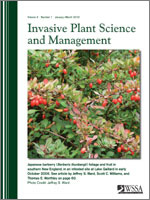Noncropland such as levees, roadsides, field borders, fencerows, and wildlife areas are vulnerable to weed invasion. Many sites have undergone frequent human disturbance, such as manipulation from surrounding land uses, and lack competitive, desirable vegetation. This study addressed the importance of revegetation in an integrated weed management program including revegetation for noncrop areas. The study evaluated 14 cool-season perennial grasses (seven native species and eight introduced species) for their establishment, vigor, and ability to suppress weeds. It also evaluated the impact of herbicides on weed control and grass establishment. Treatments were applied at three noncrop sites in Northeast California that were heavily infested with weeds. Chemical weed control during the year of seeding and the following year was critical for perennial grass establishment. Weed cover was greater than 50% whereas average seeded grass cover was less than 6% in untreated plots at all sites 2 yr after seeding. In contrast, average seeded grass cover at all sites was 22 to 31% 2 yr after seeding for treatments where herbicide use resulted in wide-spectrum weed control and grass safety. Increasing perennial grass cover decreased total weed cover across perennial grass species 1and 2 yr after seeding. Individual grass species' cover differed among sites. Two introduced grasses (tall wheatgrass and crested wheatgrass) and three native grasses (western wheatgrass, bluebunch wheatgrass, and thickspike wheatgrass) showed broad adaptation and had > 20% cover at all sites 2 yr after seeding. In herbicide-treated plots, these grasses reduced total weed cover by 43 to 98% compared to unseeded plots 2 yr after seeding.
Nomenclature: Bluebunch wheatgrass Pseudoroegneria spicata (Pursh) A. Löve ‘Secar’; crested wheatgrass, Agropyron cristatum (L.) Gaertn. ‘Hycrest’; tall wheatgrass Thinopyrum ponticum (Podp.) Z.-W. Liu & R.-C. Wang ‘Alkar’; thickspike wheatgrass, Elymus lanceolatus (Scribn. & J. G. Sm.) Gould ‘Bannock’; western wheatgrass, Pascopyrum smithii (Rydb.) A. Löve ‘Rosana’.





